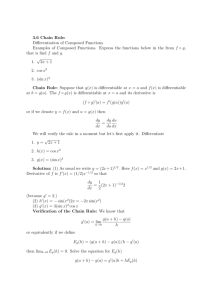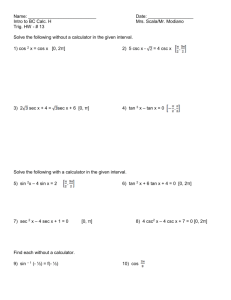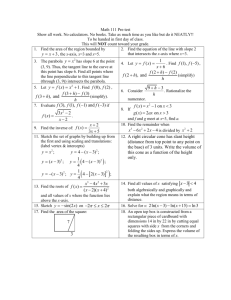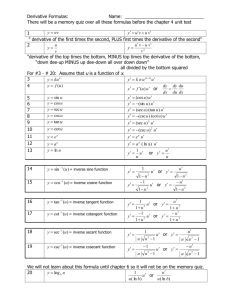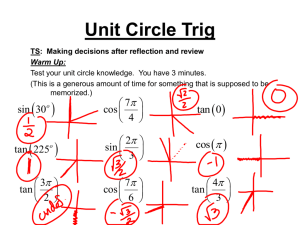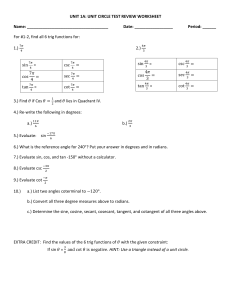Notes 5.3
advertisement
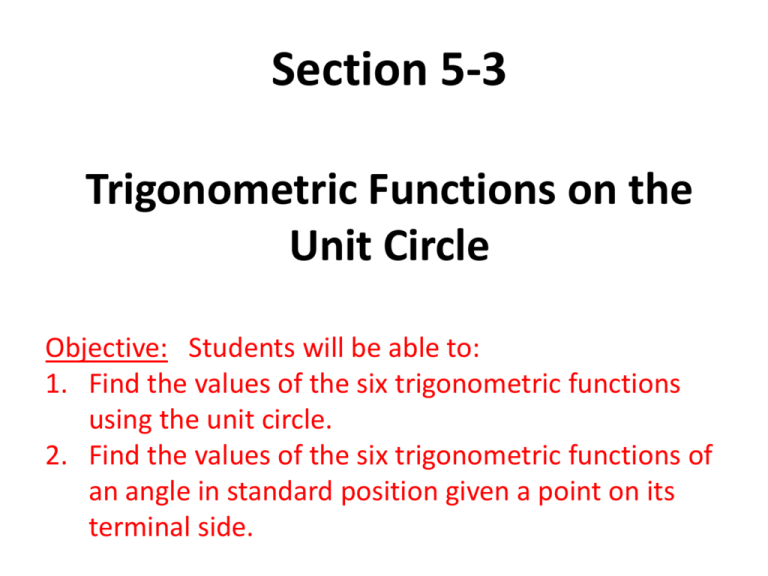
Section 5-3 Trigonometric Functions on the Unit Circle Objective: Students will be able to: 1. Find the values of the six trigonometric functions using the unit circle. 2. Find the values of the six trigonometric functions of an angle in standard position given a point on its terminal side. unit circle is a circle of radius 1 and whose center is at the origin of a coordinate The ___________ plane. The unit circle is symmetric with respect to the x-axis, y-axis, and origin. 1 1 y 𝜽 𝜽 x -1 1 -1 ** If we use are trig functions we learned in section 5.2 we can find the value of different degrees on the unit circle. We can find values for 𝐬𝐢𝐧 𝜽 and 𝐜𝐨𝐬 𝜽 using the definitions used in section 5.2. sin 𝜃 = 𝑠𝑖𝑑𝑒 𝑜𝑝𝑝𝑜𝑠𝑖𝑡𝑒 ℎ𝑦𝑝𝑜𝑡𝑒𝑛𝑢𝑠𝑒 cos 𝜃 = 𝑠𝑖𝑑𝑒 𝑎𝑑𝑗𝑎𝑐𝑒𝑛𝑡 ℎ𝑦𝑝𝑜𝑡𝑒𝑛𝑢𝑠𝑒 𝑦 𝑥 = = 1 1 Since there is exactly one point P(x,y) for an angle 𝜃, the relations cos 𝜃 = x and sin 𝜃 = y are functions of 𝜃. Because both of these functions are defined using the unit circle, they are often called circular functions ________________. The four other trig functions can also be defined using the unit circle: tan 𝜃 = 𝑠𝑖𝑑𝑒 𝑜𝑝𝑝𝑜𝑠𝑖𝑡𝑒 𝑠𝑖𝑑𝑒 𝑎𝑑𝑗𝑎𝑐𝑒𝑛𝑡 sec 𝜃 = ℎ𝑦𝑝𝑜𝑡𝑒𝑛𝑢𝑠𝑒 𝑠𝑖𝑑𝑒 𝑎𝑑𝑗𝑎𝑐𝑒𝑛𝑡 = = 𝑦 𝑥 1 𝑥 csc 𝜃 = ℎ𝑦𝑝𝑜𝑡𝑒𝑛𝑢𝑠𝑒 𝑠𝑖𝑑𝑒 𝑜𝑝𝑝𝑜𝑠𝑖𝑡𝑒 cot 𝜃 = 𝑠𝑖𝑑𝑒 𝑎𝑑𝑗𝑎𝑐𝑒𝑛𝑡 𝑠𝑖𝑑𝑒 𝑜𝑝𝑝𝑜𝑠𝑖𝑡𝑒 = = 1 𝑦 𝑥 𝑦 Example 1: a. Use the unit circle to find each value. tan 180° 𝑦 tan 180° = 𝑥 0 tan 180° = −1 tan 180° = 0 b. 1 csc (-90°) = 𝑦 1 csc (-90°) = −1 csc (-90°) = -1 sin 1800 = 0 cos 1800 = -1 sec 1800 = -1 cot 1800 = undefined csc 1800 = undefined csc (-90°) sin −900 = -1 cot −900 = 0 cos −900 = 0 tan −900 = undefined sec −900 = undefined sin , csc cos, tan, sec, cot 1 2 2 2 2 3 1 2 2 3 2 -2 90 - - 135 sin, cos, tan, sec, csc, cot none 0 1 1 3 2 2 60 120 150 30 0 360 210 - 3 2 1 -2 2 - 2 225 - 2 2 1 3 1 2 2 45 180 -1 0 2 2 2 2 -2 - 330 315 240 3 2 tan, cot sin, cos, sec, csc 1 0 300 270 0 -1 1 2 - 3 2 2 2 - 3 2 2 2 1 -2 cos, sec sin, tan, csc, cot The radius of a circle is defined as a positive value. Therefore the signs of the six trig x and ___ y in each functions are determined by the signs of the coordinates of ___ quadrant. Example 2: Use the unit circle to find the values of the six trigonometric functions for a 300° angle. ** The reference angle would be 60°. ** The terminal side of the angle intersects the unit circle at a point. Quad. II x is neg. & y is pos. ** We need to find the coordinates of this point from our special triangles from Geometry. Special Triangles 30° - 60° - 90° 45° x 2x 45° y Quad. IV x is pos. & y is neg. sin 60° = 𝑜𝑝𝑝. ℎ𝑦𝑝𝑜𝑡. cos 60° = 𝑎𝑑𝑗. ℎ𝑦𝑝𝑜𝑡. y 2 y 30° x 3 300° Quad. III x & y are neg. 45° - 45° - 90° 60° Quad. I x & y are pos. The pt. is 1 2 = = ,− 𝑥 3 2𝑥 𝑥 2𝑥 3 2 = = 1 2 3 2 ** Now that we know the point on the terminal side that intersects the unit circle, we can 1 3 , − 2 2 now find the 6 trig. functions. sin 300° = y = - 3 2 cos 300° = x = 1 2 3 𝑦 − tan 300° = = 12 = - 3 𝑥 2 1 csc 300° = 𝑦 = 1 − 3 2 1 1 sec 300° = = 1 𝑥 2 = - 2 3 = - 2 3 3 = 2 1 𝑥 = 23 cot 300° = 𝑦 − 2 = - 1 3 = - 3 3 The sine and cosine functions of an angle in standard position may also be determined terminal side using the ordered pair of any point on its ________________ and the distance between point and the_______. origin that _______ P(x, y) r y x All six trig functions can be determined using x, y, and r. (𝑟 = 𝑥2 + 𝑦2 ) Trig Functions of an Angle in Standard Position 𝑦 sin 𝜃 = 𝑟 𝑟 csc 𝜃 = 𝑦 𝑥 cos 𝜃 = 𝑟 𝑟 sec 𝜃 = 𝑥 𝑦 tan 𝜃 = 𝑥 cot 𝜃 = 𝑥 𝑦 Example 3: Find the values of the six trigonometric functions for angle in standard position if a point with coordinates (-6, 8) lies on its terminal side. r = (−6)2 + 82 ** 1st find r : r = 100 r = 10 sin 𝜃 = 𝑦 𝑟 cos 𝜃 = 𝑥 𝑟 tan 𝜃 = csc 𝜃 = 𝑦 𝑥 𝑟 𝑦 4 5 = 8 10 = = −6 10 = - = 8 −6 = - = 10 8 = 5 4 3 5 4 3 sec 𝜃 = 𝑟 𝑥 = 10 −6 = - 5 3 cot 𝜃 = 𝑥 𝑦 = −6 8 = - 3 4 If you know the value of one of the trig functions and the quadrant in which the terminal side lies in, you can find the other five trig functions. Example 4: Suppose is an angle in standard position whose terminal side lies in Quadrant II. If csc = 8 , find the values of the remaining five trigonometric functions of . 3 ** Since the point lies in Quad. II, x is neg. & y is pos. csc 𝜃 = Find x : 𝑟 𝑦 , so r = 8 and y = 3 sin 𝜃 = 𝑥 2+ 𝑦 2 = 𝑟2 𝑥 2 + 9 = 64 𝑥 2 = 55 x = ± 55 𝑦 𝑟 = 3 8 cos 𝜃 = 𝑥 𝑟 = − 55 8 tan 𝜃 = 𝑦 𝑥 = 3 − 55 = - sec 𝜃 = 𝑟 𝑥 = 8 − 55 = - cot 𝜃 = 𝑥 𝑦 = − 55 3 x has to be - 55 3 55 55 8 55 55
